Other cooking tools
- Ami shakushi: Scoop with a net bottom
- Kushi: Skewers
- Makisu: Bamboo mat for sushi rolls
- Oroshigane: Graters
- Oshizushihako: Box for pressed sushi
- Saibashi: Japanese kitchen chopsticks
- Shamoji: Rice paddle
- Tsukemonoki and tsukemonoishi: Japanese-style pickle press
- Urokotori: Fish scaler
- Zaru: Bamboo draining basket
- Shokado bento: Bento box
Ami shakushi
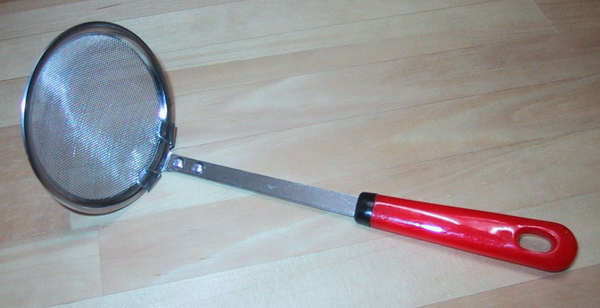
Ami shakushi is a ladle or scoop used in the Japanese kitchen. The ladle is made from a fine wire mesh and is used to remove small pieces of unwanted food or foam from a liquid. For example in deep frying, the ami shakushi is used to remove small drops of batter during the frying of tempura. Another example would be the removal of foam from a miso soup to achieve a more pleasing aesthetics.
Kushi
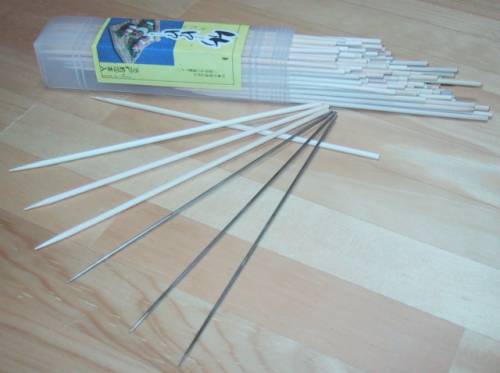
Bamboo and metal kushi (15 cm)
Kushi are skewers used in Japanese cuisine to hold pierce and hold food for grilling and frying, such as yakitori. They range in length from about 15 to 30 cm. Kushi may be made of steel, bamboo, or wood. The steel and wooden varieties are reusable, while those made from bamboo are usually only used once and discarded. Bamboo kushi are usually the type that customers purchasing food from street vendors would be given.
Makisu
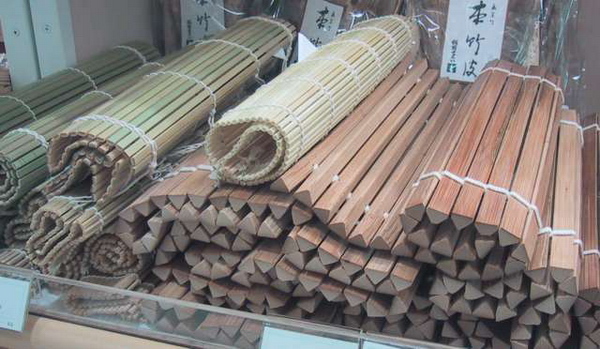
A selection of makisu mats with bamboo sticks of different thicknesses
In Japanese cooking, a makisu is a mat woven from bamboo and cotton string that is used in food preparation. Makisu are mostly commonly used to make a kind of rolled sushi called makizushi , but they are also used to shape other soft foods such as omelets, and to squeeze excess liquid out of food.
A makisu is usually 25cm x 25cm, although this may vary. There are two variations, one with thick bamboo strips and the other with thin. Experts consider the thick mat more versatile, while the thin mat is designed specifically for makizushi.
After use, a makisu should be thoroughly air dried to avoid the growth of bacteria and fungi. Some cooks also cover the makisu with plastic film to reduce the cleaning effort after use. This is especially necessary for producing uramaki, a kind of maki sushi with the rice on the outside of the roll.
Oroshigane
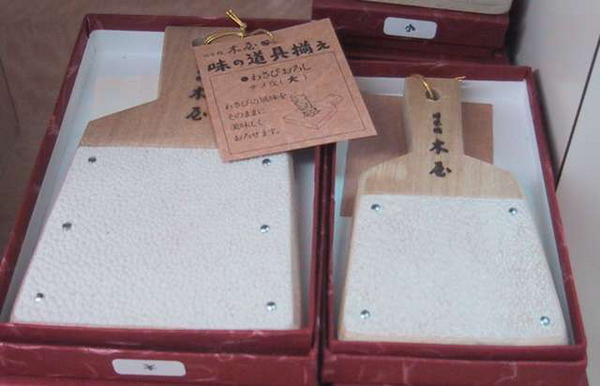
Orishigane grater made with shark skin
Oroshigane (grating-metal), also known as oroshiki are graters for use in the Japanese kitchen.
These oroshigane differ significantly from Western-style graters, as they produce a much finer grating. Traditionally, these graters were tin-coated copper plates with many small spikes gouged out of the metal, but no actual perforations through the metal. These graters are still considered the best and are used by professional chefs. For preparing wasabi and yamaimo, graters with the surface made from shark skin were exclusively used. These have an even finer grating surface than a metal one; much closer to a sanding paper. However, nowadays non-professional cooks usually use much less expensive graters made from other metals, plastic, or ceramics. A modern variation of these graters also has perforations and may come with a matching box so that the grated material drops through the grater into the box.
Wasabi on metal orishiganeThere are two versions of the grater in common use with different coarseness. The coarse grater is used to grate daikon and the like, whereas the fine graters are used for grating wasabi or ginger. The fine graters are also sometimes sold as a wooden board covered with shark skin, which has many tiny teeth (dermal denticles) and give it a feel similar to sandpaper.
A similar tool to the oroshigane is the suribachi and surikogi (mortar and pestle).
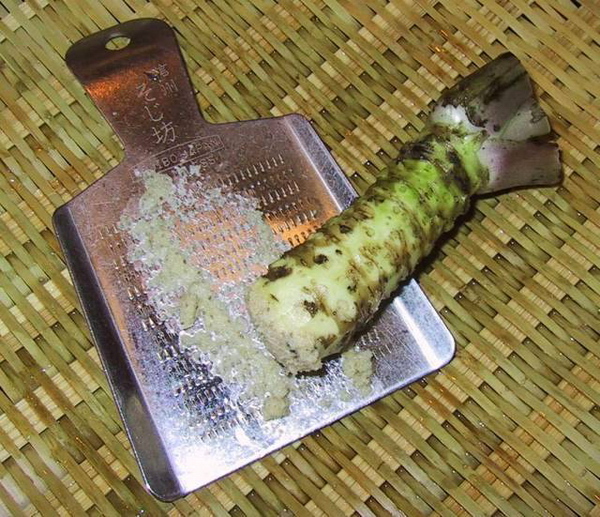
Wasabi on metal orishigane
Oshizushihako
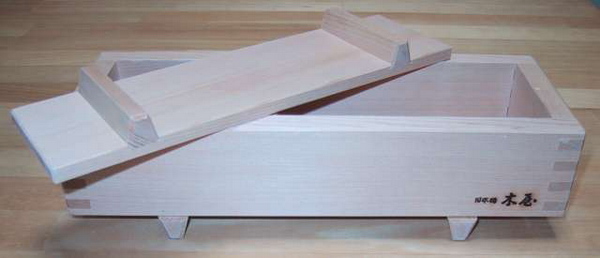
Wooden oshizushihako
A Oshizushihako (pressed sushi box) is a box or mold used to make oshizushi (pressed sushi). The box is traditionally made from wood, but nowadays often made from plastic. The box can be taken apart into three parts, a bottom part, the rectangular walls, and a top part. Before use the wooden box should be put in water so that the rice sticks less to the box. The bottom part and the top part can be covered with a layer of plastic foil for easier cleaning. The bottom part and the walls are assembled before the rice and the topping is added. Next, the top part is used to press onto the sushi, hence the name pressed sushi. For disassembly the rectangular walls are pulled up while the top part still presses onto the sushi. After removing the top part the sushi is cut and can be served.
A variant of the oshizushihako has half cylindrical shapes cut from the thicker top and bottom parts such that the sushi is pressed in a cylindrical shape.

Saibashi
Saibashi are Japanese kitchen chopsticks, which are a special version of chopsticks (hashi) used in the Japanese kitchen. They are used in the preparation of Japanese food, and are not designed as a tool for eating.
These chopsticks are very practical and allow the handling of hot food with one hand, and are used similarly to regular chopsticks. These chopsticks have a length of 30cm or more, and usually are looped together with a string at the top.
Most chopsticks are made from bamboo, but for deep frying it is recommended to get metal chopsticks with bamboo handles called kinzokuseinohashi (chopsticks made of metal), as the tips of bamboo chopsticks discolor and get greasy after repeated use in hot oil or fat. The wooden handles insulate the hand from the heat conducting metal.
Shamoji
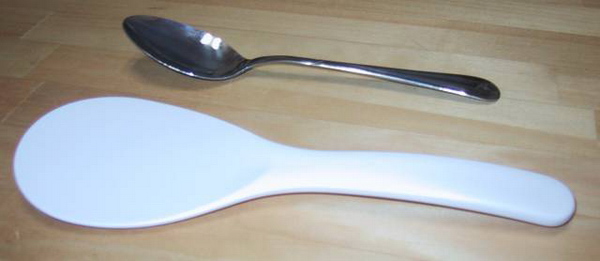
Shamoji and a table spoon for size comparisom
A shamoji is a flat rice paddle used in the Japanese kitchen.
The shamoji is used to stir and to serve rice, especially to mix vinegar into the rice for producing sushi rice. They are usually inexpensive and made traditionally from bamboo, wood, or lacquer, and nowadays often from plastic. The shamoji must be dipped in water frequently during use to prevent rice from sticking to it. More expensive plastic shamoji have a non-stick surface. Metal is rarely used, as this is more likely to cut the rice grains or to damage the wooden tub used traditionally for mixing.
When serving using a shamoji, it is important to serve gently so that cooked rice grains would not be pressed flat.
Tsukemonoki and tsukemonoishi
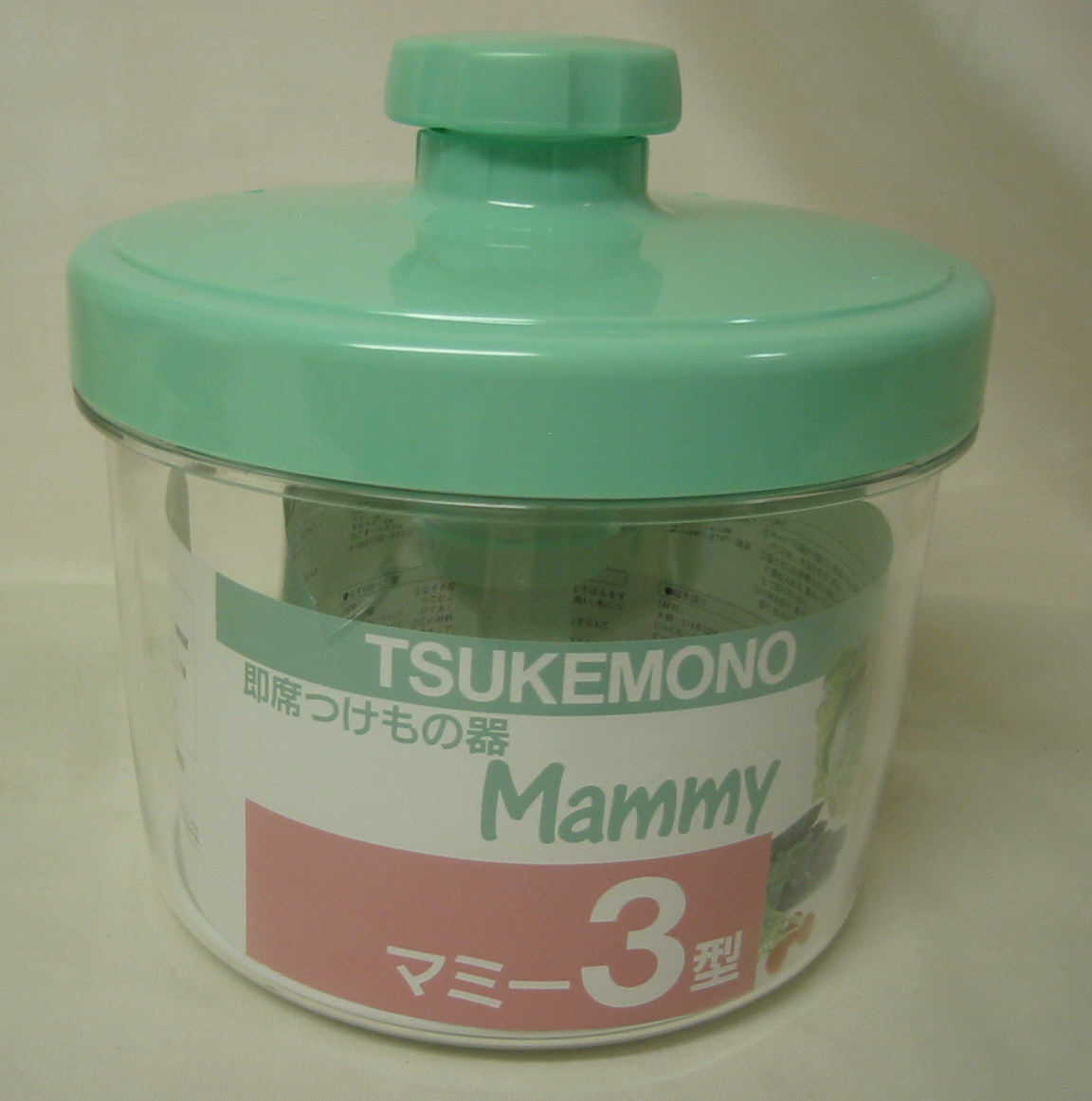
Tsukemono are Japanese pickles. They are served with rice, and sometimes with beverages.
The most common kinds are pickled in salt or brine. Soy sauce, miso, vinegar, nuka, and sake are also useful for pickling.
Daikon, ume, turnips, Chinese cabbage, and cucumbers are among the favorites.
Traditionally, the Japanese prepared tsukemono themselves with a tsukemonoki. Pickling was one of the fundamental ways to preserve food. Nowadays, pickles, or tsukemono can be bought readily in the supermarket, but many Japanese still make their own pickles. Typically, all that's needed to make pickles is a container with the food to be pickled, salt, and pressure on top of the pickles.
A Tsukemonoki (vessel for pickled things) is a Japanese pickle press. The pressure was generated using heavy stones called tsukemonoishi (stone for pickled things) with a weight of 1 to 2 kilograms, sometimes more. This type is still in use, with the container being plastics, wood, glass or ceramics. Before tsukemonoishi came into use, the pressure was applied by driving a wedge between a handle of the vessel and its cover.
The weights are either stone or metal, with a convenient handle on top and often covered with a layer of food-neutral plastic. Another modern type of pickle press is usually made from plastic, and the necessary pressure is generated by turning a screw and clamping down onto the pickles.
Urokotori
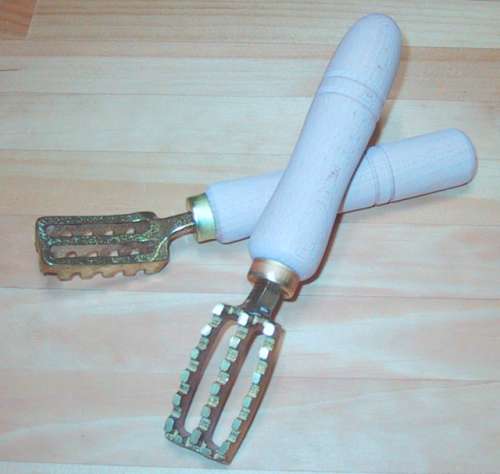
Two urokotori of slightly different sizes
A Urokotori (scaler) is a fish scaler is used in the Japanese kitchen to remove the scales from the skin of fishes before cooking. Alternatively it is possible to remove the scales with a knife, but this is more difficult and there is a higher risk of cutting the skin of the fish, especially with small fishes as well as the own hand. Often the fishmonger can scale the fishes for the customers, so this tool may not be needed. The urokotori is pulled across the skin of the fish from the tail to the head repeatedly to remove the scales.
Zaru
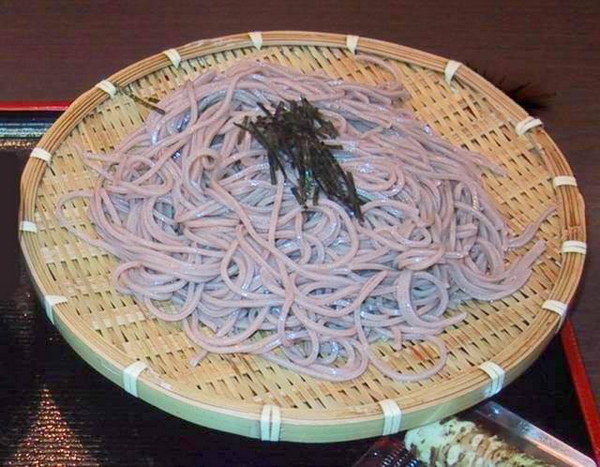
Soba served on a zaru
The Zaru is a draining basket made from bamboo used in the preparation and presentation of Japanese food. It can be used similar to a sieve or colander in western cooking. Additionally, well designed zaru can be used to present food directly, as for example zaru soba. Recently, plastic and metal versions have come into use for cooking, but are rarely used to present the food, as traditional bamboo usually has a much more pleasing aesthetics.
Similar to the makisu, a zaru should be allowed to dry well after use and stored in a dry place to extend the lifespan of the tool and to avoid the growth of bacteria and fungi on the mat. However, they should not be dried too much and drying by the sunlight should be done carefully as this would crack the zaru.
Shokado bento
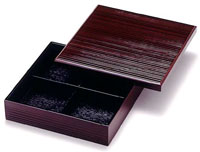
Japanese Lunchbox
Shokado bento is a traditional black-lacquered Japanese bento box, a type of lunchbox. It inspired IBM's ThinkPad design.